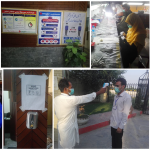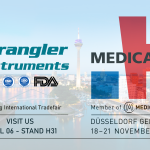
Sabmed dutifully follows the Official Public Service Announcement on COVID-19 from the State Government. Henceforth implemented the precautionary measures at facility.
Industrial workers are also exposed to hazards that put them at risk of infection with an outbreak
pathogen, in this case COVID-19. Hazards include long working hours, psychological distress, fatigue,
and occupational burnout. These protocols have been designed in order to minimize the potential for
contracting COVID-19 and subsequently reducing its spread at industrial level including specific
measures needed to protect occupational safety and health
Individual Precautions:
Employees working in industries should strictly follow the preventive measures by
• Using alcohol-based (70 percent) sanitizer or wipes at entry and exit points
• Discontinue Biometric attendance
• Covering cough or sneeze with tissue or a shoulder or elbow
• Avoid touching eyes, nose, or mouth.
• Repeated and diligent handwashing least 20 seconds after every hour
• Clothes of the workers and management shall be frequently disinfected, especially following
contact with any frequently-touched surfaces such as door handles, elevator buttons, machines,
handrails, drinking fountains, computers, telephones, fax machines keyboards, etc.
• Keeping up-to-date on the latest information on COVID-19 (Federal & provincial govt health
websites, WHO etc.)
• Seeking the assistance of health care professionals if any worker starts to feel unwell and avoid
contact with others when unwell. Workers should not attend work while unwell
Administrative Controls:
Administrative controls are changes in work policy or procedures to reduce or minimize exposure to a
hazard by the worker or employer. All industrial zones must assess the risk in consultation with
workers and implement control measures to minimize the spread of the virus, these may include:
• Ensuring sick workers to stay at home
• Minimizing contact among workers, clients, and customers by replacing face-to-face meetings
with virtual communications and implementing telework if feasible
• Establishing alternating days or extra shifts that reduce the total number of employees in a
facility at a given time, maintaining a full onsite work week
• Providing information, instruction and training on occupational safety and health
• Providing workers with up-to-date education and training on COVID-19 risk factors and
protective behaviors (e.g., cough etiquette and care of PPE)
• Providing tissues, no-touch trash cans, hand soap, alcohol-based hand rubs containing 70
percent alcohol, disinfectants, and disposable towels for workers to clean their work surfaces
• Providing employees good quality masks, safety glasses, gauze caps and gloves
• Ceasing non-essential work activities that involve close personal contact (less than 2m)
• Social distancing at preferably 2 meters (1 person per 4sqm indoors)
• Modifying shifts and rosters to reduce peak periods
• Maintaining the record of all individuals and vehicles entering and exiting the premise
Preventive Measure at Industrial Premises:
Implementing controls to reduce environmental exposure, including:
• Inspecting and reviewing air conditioning and ventilation systems
• Increasing cleaning and disinfection of high traffic areas or shared surfaces
• Providing cleaning products and instruction for cleaning workspaces
• Providing instruction and amenities for personal hygiene and infection control
• Determining areas to be disinfected and cordon off using signs and physical barriers such as
caution banner tape, safety cones, etc.
• Encouraging workers to dedicate separate pairs of clothes for work within a unit or premise.
• Ban entry of unauthorized persons to industrial premises temporarily
• Standard SOPs of COVID-19 must be displayed in premises in local language
• Ensuring availability of disposable cups, glasses and plates for drinks and meals and their
disposable after one-time-use
• Isolation or quarantine area shall be maintained to lodge suspected workers who should be
screened for COVID19 test, and carry out further process, in case of positive result of the test
• Monitoring and Inspection should be done on regular basis to ensure the adaptation of protocols
Preventive Measures for Industrial transporters / Vehicles:
• Industries should implement higher driver health and safety standards for loading and unloading
goods (particularly in quarantine areas) and concerning the carriage of documents to
demonstrate compliance with health rules
• Must ensure traceability in recording and maintaining driver and worker movements
• Governments and authorities should clearly communicate enforcement procedures for transport
vehicles, drivers and cargo especially for quarantine areas e.g.
o Drivers must wear masks, head gear and gloves while traveling
o Disinfection of transport vehicles of industries before boarding
o Ensure washing of all transport vehicles leaving the industrial exit
o All the supplies/deliveries products shall be properly sanitized and disinfected before
exit
o Ensuring that windows are to be kept open while travelling
o Discourage use of Cooling (air conditions), and heating systems of the transport vehicles
– use WHO recommendations
• Governments and authorities should closely coordinate and publish measures to mitigate the
impact of the restrictions they adopt on supply chains and related movements of goods and
people. Encourage interrupted supply/delivery chains
• Supply/delivery of items from geographic areas severely affected by COVID-19 may be
delayed or cancelled with or without notification.




